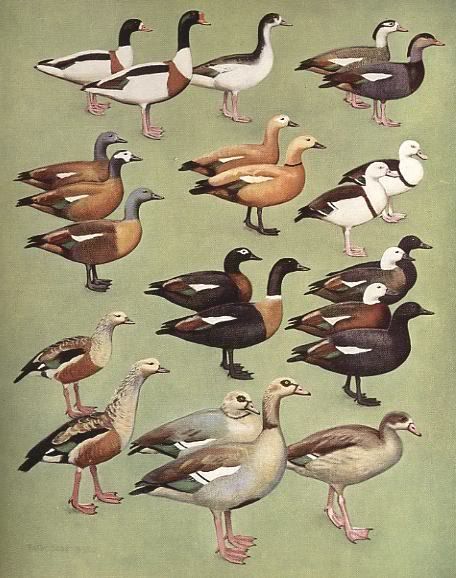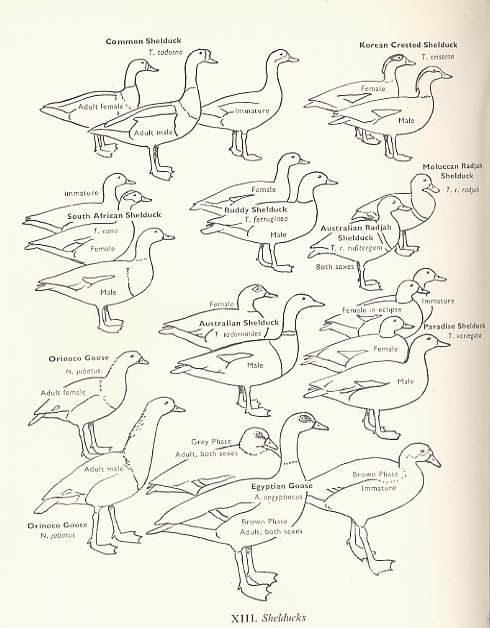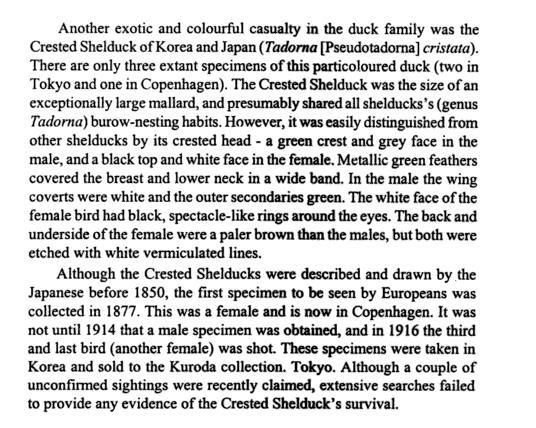|
|
Post by sebbe67 on Mar 4, 2005 12:10:56 GMT
Tadorna cristata
There are only 3 specimens of this species in museums two in Tokyo and one in Copenhagen. This bird was desribed 1850 and 1877 was the first specimens collected. It wasent until 1914 a male was seen of this species. The last confirmed sighings of this species are from 1916 there has been several unconfirmed sightings but none has shown to be this species and hunting compered with habitat lost made this duck extinct.
|
|
|
|
Post by Melly on Mar 4, 2005 12:29:59 GMT
The Crested shelduck is considered CR (Possible extinct) by the criterias of the IUCN.
There have been no confirmed records of this species since 1964 despite some large-scale publicity campaigns. However, it may well remain extant because there have been a number of unconfirmed records in north-east China, where relatively little fieldwork has been carried out. Searches are also required in eastern Russia, and North Korea. Any remaining population is likely to be tiny, and for these reasons it is treated as Critically Endangered.
The problem was the students who have seen the Shelducks in 1964 haven't photographed this species. But there are some drawings.
|
|
|
|
Post by sebbe67 on Mar 7, 2005 7:26:40 GMT
 stuffted male and feamle |
|
|
|
Post by Melanie on Jun 5, 2005 18:48:39 GMT
|
|
|
|
Post by another specialist on Jun 5, 2005 18:57:23 GMT
|
|
|
|
Post by another specialist on Jun 8, 2005 7:32:32 GMT
Justification There have been no confirmed records of this species since 1964 despite some large-scale publicity campaigns. However, it may well remain extant because there have been a number of unconfirmed records in north-east China, where relatively little fieldwork has been carried out. Searches are also required in eastern Russia, and North Korea. Any remaining population is likely to be tiny, and for these reasons it is treated as Critically Endangered. Family/Sub-family ANATIDAE Species name author (Kuroda, 1917) Taxonomic source(s) Sibley and Monroe (1990, 1993) Identification 60-63 cm. Unmistakable, dark shelduck with red bill and legs and mostly white wing-coverts. Male has greyish head sides, upper foreneck, lower mantle, scapulars and belly, and pale rufous undertail-coverts. Female is similar, but with white face and "spectacles", whiter lower head sides and upper foreneck, rather uniform brownish-grey upperparts and whitish-buff barring to lower foreneck and belly. Population estimate Population trend Range estimate (breeding/resident) Country endemic? <50 unknown - No Range & population Tadorna cristata is known from a small number of records from Primorye, Russia, Hokkaido, Japan (single 19th century record) and South Korea. The most recent was a sighting of a male and two females in May 1964, on islands south of Vladivostok, Russia. A sighting of two males and four females was claimed in North Korea in March 1971, but serious reservations have recently been expressed about the reliability of this record. There have also been several unconfirmed records from north-east China, in Heilongjiang, Jilin, Liaoning and Hebei. Given the paucity of recent records, it is likely that it has a very small population. Ecology It has mainly been recorded in pairs or small flocks in coastal localities, often near river mouths. However, several of the unconfirmed reports in north-east China are from inland localities. It has been speculated that it may breed in mountainous areas, possibly away from water or on volcanic lakes, moving to the coast outside the breeding season. Threats If it still survives, its numbers are likely to be so low that it would be vulnerable to a chance or accidental extinction. Several of the historical localities are close to the area affected by the implementation of the large-scale Tumangan Development Project. Conservation measures underway CMS Appendix II. In 1983, three million leaflets on this species were distributed in Russia, Japan, China, South Korea and North Korea. However, there was little response, with the only result the single unconfirmed record from North Korea. A new investigation was made in China from 1986-1990, through a publicity campaign and the distribution of 15,000 leaflets in 25 provinces and autonomous regions. This generated 82 responses, but no confirmed records. Conservation measures proposed Continue to search for the species within its potential range through publicity campaigns and the distribution of illustrated leaflets. Conduct surveys at historical localities and in those areas where there have been unconfirmed sightings. www.birdlife.net/datazone/search/species_search.html?action=SpcHTMDetails.asp&sid=401&m=0 |
|
|
|
Post by another specialist on Jun 8, 2005 7:35:20 GMT
|
|
|
|
Post by dysmorodrepanis on Jun 22, 2005 2:17:07 GMT
The problem was the students who have seen the Shelducks in 1964 haven't photographed this species. But there are some drawings. I have seen them (they are in some German paper on the subject) and they are rather convincing. One showing the bird from behing as it takes flight clearly shows the color pattern of shelduck wings (black primaries, brown secondaries, green speculum, white coverts). Either the sighting is genuine, or it's a well-researched prank (it's probably genuine IMHO  ) |
|
|
|
Post by another specialist on Jul 22, 2005 7:24:47 GMT
what german paper? have you got it?
|
|
|
|
Post by dysmorodrepanis on Jul 23, 2005 23:00:00 GMT
what german paper? have you got it? Nowak, E. (1983): Die Schopfkasarka, Tadorna cristata (Kuroda 1917) - eine vom Aussterben bedrohte Tierart (Wissensstand und Vorschläge zum Schutz). Bonner zoologische Beiträge 34:235-271 A very long and exhaustive treatment, only the summary is in English (nothing new, basically this paper is what today's knowledge - as here www.rdb.or.id/view_html.php?id=270&op=tadocris, if the server's online - is founded on). Photos (b/w) of all museum specimens and centuries-old Japanese sources (hunting manuals, playing cards etc) and the Russian sketch. I have it as a hardcopy only and it is not online, but any good library (at least in Europe) should be able to dig up a copy. The original Russian reference of the 1964 record is: Labzyuk WI & Nazarov, JN (1967): O redkikh i novykh ptitsakh yuzhnogo Primorya (On rare and new birds from the Southern Primorye). Ornitologia (Moskva) 8:363-357 and Labzyuk WI (1972): Chochlataya pyeganka w yuzhnom Primorye (Crested Shelduck in the Southern Primorye). Ornitologia (Moskva) 10:356-357. A rough translation of the report from the 1972 paper follows (my translation from Nowak's German translation): "On May 16th, 1964, during a breeding population count of Spectacled Guillemots done from a rowing boat near an unnamed rocky islet NW of Matveyev Island, we saw on a cliff 50 m from shore, from a distance of 20-30 meters, a large duck sitting on a stepped stone together with Harlequin Ducks. Waves of up to scale 3 prevented the use of binoculars for observation. The duck was about twice the size of the Harlequin Ducks, apart from that, the bird's coloration was also conspicuous. The red legs and beak, which stood prominently out from the rocky background and reminded in intensity of the corresponding parts' coloration in the Red-breasted Merganser could not be overlooked. In the shoulder area, a large white spot bordered below and tailwards by the dark secondaries stood out from the generally dark plumage. As the boat drifted closer and the duck, stretching its neck, moved the head in alarm, a closer look at the coloration was possible. Head and neck were greyish, on the head and the hind part of the neck there was a black stripe down to the back, the black crop and breast were clearly visible, the flanks were dark grey. Wind and waves drifted the boat even closer, which obviously startled the Harlequin Ducks, which sat markedly above the wave level. Following them, some more Harlequin Ducks which had been sitting hidden behind the rock flew up, and two more ducks, which differed from the one described above by a monotonous greyish-brown coloration, from which the bright red beak and the off-white head with a black stripe on the top stood out. After this, the first duck also flew up. It was possible to observe the rusty or ochre undertail plumage. The flight of the Crested Shelduck, clumsy at first, changed to light and fast, with only few and strong wing-beats. At first, they followed the Harlequin Ducks, later they veered off and left, after passing Matveyev Island on the W shore, to the SW." There is an ad hoc drawing by Labzyuk from the day of the observation. It is interesting because the description might be penned from a textbook (as in 'too good to be true'), but in the drawing he puts the ruddy coloration of the undertail plumage on top of the tail, as it would have seemed to a casual observer viewing the bird fly away. A person faking such an observation would not make such an error (the description above is written in retrospect, therefore, he has it correct there). |
|
|
|
Post by another specialist on Jul 24, 2005 6:15:39 GMT
thanks for the information gratefully received.
|
|
|
|
Post by another specialist on Nov 19, 2005 22:11:27 GMT
Crested Shelduck Tadorna cristata Critically Endangered. This species is known from a small number of records from Primorye in Russia, Hokkaido in Japan (a single nineteenth century record) and South Korea. The last sighting was of a male and two females in May 1964 on islands south of Vladivostok, Russia. A sighting of two males and four females was claimed in North Korea in March 1971, but serious reservations have recently been expressed about the reliability of this record. There have also been several unconfirmed records from north-east China, in Heilongjiang, Jilin, Liaoning and Hebei. Searches are needed in wetlands (including forest rivers) in eastern Russia, North Korea and northeastern China. www.orientalbirdclub.org/publications/basiafeats/lost.html |
|
|
|
Post by another specialist on Jul 24, 2007 20:09:00 GMT
Shelducks with Color Plate & Matching Species Key Common Shelduck, Korean Crested Shelduck,, South African Shelduck, Ruddy Shelduck, Australian Radjah Shelduck, Moluccan Radjah Shelduck, Paradise Shelduck, Australian Shelduck, Orinoco Goose, Egyptian Goose Color Plate;  Species Key;  mawba.com/shelducks.htm mawba.com/shelducks.htm  |
|
|
|
Post by Melanie on Jan 1, 2008 12:33:48 GMT
|
|
|
|
Post by another specialist on Jun 11, 2008 15:00:38 GMT
|
|
|
|
Post by another specialist on May 3, 2009 19:25:04 GMT
 Encyclopaedia of Birds By Arvind N. Shukla, Rajiv Tyagi |
|
|
|
Post by surroundx on Jul 8, 2012 11:59:16 GMT
|
|
|
|
Post by koeiyabe on Apr 23, 2015 20:35:20 GMT
|
|
|
|
Post by koeiyabe on Apr 23, 2015 20:38:47 GMT
|
|
|
|
Post by koeiyabe on Dec 12, 2015 19:34:24 GMT
 "The Earth Extinct Fauna (in Japanese)" by Tadaaki Imaizumi (1986) |
|